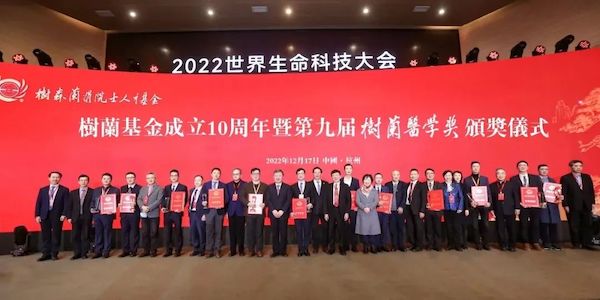Home> News
Four BSC members receive Shulan Medical Award
Updated: 2022-12-30

A ceremony is held on Dec 17, in Hangzhou in Zhejiang province, to celebrate the 10th anniversary of the establishment of the Academician Shusen Lanjuan Talent Foundation and to commend the winners of the ninth Shulan Medical Award. [Photo/shulanfund.org]
A ceremony was held on Dec 17 in Hangzhou, East China’s Zhejiang province, to celebrate the 10th anniversary of the establishment of the Academician Shusen Lanjuan Talent Foundation and to commend the winners of the ninth Shulan Medical Award.
Four experts at the Biophysical Society of China (BSC) won the award. They are Tan Weihong, an academician with the Chinese Academy of Sciences, who won the Shulan Medical Award, and professors Zhang Yan, Tan Tao, and Jin Hongfang, who won the Shulan Medical Youth Award.
Launched in the spring of 2022, the award attracted experts and scholars from 70 universities, hospitals and research institutes. Three winners received the Shulan Medical Award and 12 individuals won the Shulan Medical Youth Award.
Profiles of the award winners
Tan Weihong, an expert in molecular medicine
Tan was born in Changsha, the capital of Hunan province, in 1960. He received a PhD in physical chemistry from the University of Michigan in 1992. In 2015, he was recognized as an academician of the Chinese Academy of Sciences and in 2016 as a fellow of the World Academy of Sciences. Currently, Tan serves as director of the Institute of Basic Medicine and Cancer at the Chinese Academy of Sciences, president of the Zhejiang Cancer Hospital, director of the Institute of Molecular Medicine at Shanghai Jiao Tong University, director of the State Key Laboratory of Chemo/Biosensing and Chemometrics at Hunan University, and chairman of the Molecular Medicine Professional Committee at the Chinese Chemical Society. As a pioneer of China’s molecular medicine, he proposed a SELEX method to select aptamers, laying an important scientific and technological foundation for their medical application, and prepared aptamer-drug conjugates for the first time, opening a new channel for the research and development of targeted drugs. Tan has published nearly 900 SCI papers. He won the second prize of the State Natural Science Award in 2014 and 2020, the 2018 Science and Technology Progress Award of the Ho Leung Ho Lee Foundation, the 2018 Award in Spectrochemical Analysis granted by the American Chemical Society, and the Pittsburgh Analytical Chemistry Award in 2019.
Zhang Yan, a specialist in structural pharmacology
Zhang was born in 1985 in Jining, East China’s Shandong province. Currently, he serves as vice-dean of the School of Basic Sciences at Zhejiang University, deputy director of the Innovation Institute for Artificial Intelligence in Medicine and leader of the innovative project on protein machines and cell fate regulation at the university. Zhang graduated from the Shanghai Institute of Organic Chemistry at the Chinese Academy of Sciences in 2013, having majored in organic chemistry. He conducted postdoctoral research at the University of Michigan and Stanford University. At the beginning of 2018, Zhang returned to China and was successively elected as a Changjiang Scholar under the Ministry of Education, a Qiushi Distinguished Professor of Zhejiang University, a tenured full professor, and a Distinguished Expert of Zhejiang Province. His research projects have received funding from the Distinguished Young Scholars Program of the National Natural Science Foundation of China, the Thousand Talents Program, and the National Natural Science Foundation of China, and have been listed as key research and development programs for young scholars launched by the Ministry of Science and Technology. Zhang has made a series of innovative achievements in GPCR signal transduction regulation mechanism and precise intervention means, providing a theoretical basis for precise treatment of major diseases and exploration of innovative targets. He has published nearly 40 papers as the corresponding author or first author (co-author) in journals such as Nature (eight papers), Science (two papers) and Cell, with the number of Google Scholar citations exceeding 4,000.
Tan Tao, a specialist in reproductive and developmental biology
Tan was born in 1981 in Kunming, Yunnan province. He graduated from Lanzhou University in 2004, majoring in biological science. Mainly specialized in early embryonic development and reproductive regulation of primates, Tan invented an in vitro culture system of cynomolgus monkey embryos, which revealed key processes in the development of fetal tissues and germ cells and deepened the understanding of early human embryos. Tan and his team created chimeric human-monkey embryos, answered the basic scientific questions such as how xenogeneic chimeric cells interact and how differences in development procedures are regulated, and provided a theoretical basis and potential intervention targets for improving the chimeric degree of human cells in xeno-embryos in the future, which is of guiding significance for studies on organ regeneration. Tan has published more than 10 articles as the corresponding author on Science, Cell and other journals.
Jin Hongfang, a pediatric cardiologist
Jin was born in 1978 in Handan, Hebei province. She graduated from Peking University in 2006, majoring in pediatrics. She is currently a professor, researcher, doctoral supervisor and deputy director of administration at the Pediatric Department of Peking University First Hospital. Jin has made breakthroughs in the discovery of new gaseous signaling molecules and the diagnosis and treatment of pediatric cardiovascular diseases. She pioneered the understanding that endogenous SO2 is a new gaseous signaling molecule for cardiovascular regulation, opening up a new research field of sulfur-containing gaseous signal molecular biology. She also focused on the finding, diagnosis and treatment of basic cardiovascular diseases, such as syncope in children, where she made outstanding achievements. Jin took the lead in proposing a series of new diseases such as children's sitting intolerance, put forward innovative strategies for individualized treatment of syncope in children, chaired the formulation of international guidelines for the diagnosis and treatment of children's syncope, and led the international forefront of clinical diagnosis and treatment of the disease and cardiovascular disorders. She has published 196 SCI papers and won two science and technology awards at provincial and ministerial levels.
